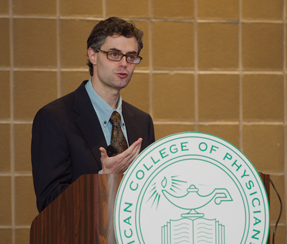The Court, the College and an inevitable health care revolution
The Supreme Court is considering the constitutionality of health care reform. Regardless of its decision, health care will change from economic pressures and a desire to make the system better from within.
As I write this, the Supreme Court is expected to soon announce its decision about the Patient Protection and Affordable Care Act (ACA). There has been a great deal of speculation about the decision, its impact and the future of health care reform. The ACA is a complicated and comprehensive piece of legislation. In my mind, its most important features are those that significantly reduce the number of uninsured, a goal long championed by the College. The Court's decision will likely define the direction of health care reform for at least a decade.
We must not forget that whatever is decided, there is still a health care revolution occurring. Major economic pressures are transforming practices, hospitals and health systems. This transformation in health care delivery is inevitable and cannot be overturned by the Supreme Court.
Several factors are driving these changes. The aging of the baby boom generation combined with greater longevity, and an increasing burden of chronic disease are inevitable. By 2050, the population of people older than 65 years will more than double and the percentage of the gross domestic product spent on Medicare will almost triple.
Health care payers are pushing for better cost control and higher value. Medicare, Medicaid and commercial payers are all pursuing strategies to improve the value of health care services. These strategies include greater transparency of quality measures, outcomes and costs, and new payment approaches such as accountable care organizations and shared savings models. The emphasis is on increased value, and the College's High Value, Cost-Conscious Care Initiative is an important program to help prepare our members for this new environment.
In the last 30 years of practice, I have seen tremendous advances in medical science, leading to dramatic improvement in outcomes, life expectancy and quality of life for our patients. In those 30 years we have seen AIDS change from a uniformly fatal disease to a manageable chronic disease. The same is true for many types of cancer. We have seen a major decline in coronary disease incidence and mortality due to use of statins and stents, in addition to the impact of declining rates of smoking.
Advances in total joint replacement now include virtually every major joint in the body, and the use of biological therapies has transformed the outcomes for rheumatoid arthritis, vasculitis, inflammatory bowel disease, psoriasis and many other conditions. These are effective, yet expensive interventions. The next 30 years will bring more effective treatments for many other diseases, but often at high cost.
Health care system inefficiency raises the cost of care. In the past, I often found it easier to repeat a test than to find the prior one done by another physician or at a distant hospital. The payment system rewarded high volume and offered few incentives for care coordination, quality or cost control.
There are a number of inevitable consequences of the economic pressures in health care. Hospital and health system consolidation will continue to grow. Currently 60% of hospitals are part of consolidated health systems. Less efficient small facilities will find it difficult to survive and will consolidate, transition to ambulatory centers or close.
Experiments in delivery system reform will attempt to increase the value of health care services. Concepts such as accountable care organizations and shared savings are being evaluated in commercial insurance settings. Many insurers are supporting the patient-centered medical home as a way to both improve care and control costs. It is being improved with the development of the patient-centered medical neighborhood, recognizing the importance of integrating specialty physicians into the medical home model.
Physicians are increasingly employed by medical groups or hospitals. Hospitals are employing physicians to secure their referral bases and develop alternative delivery models.
The financial and regulatory pressures of running a small practice are driving physicians to align with hospitals or other delivery systems. Residents coming out of residency or fellowship will have higher levels of debt, and a desire for greater work-life balance. Consequently, they are less likely to take the risk of starting a new independent practice.
Electronic health records and other forms of information technology are becoming important tools to transform health care and manage patient populations.
Regardless of the outcome of the Supreme Court's decision, ACP members can be assured of three things. First, the College will respond to any court decision with a robust policy process and effective advocacy for the issues we believe in. Second, as events continue to unfold, we will remain focused on assisting our members in understanding the impact of new policy developments and changes in the practice environment. Third, the College will continue to work to help our members be prepared for the ever-changing health care system. As ever, the focus will be less on momentary political shifts in direction than on promoting the right answers for our members and those they serve.
The College continues to support rational change in the health care system that is right for patients. We believe that internal medicine and internal medicine subspecialties bring great value to the health care system and that value should be recognized. We also believe we can get much better. I am humbled by the opportunity to stand beside you as we work to ensure a brighter future for our patients and our profession.



